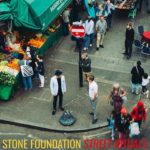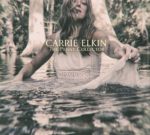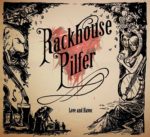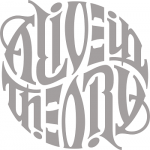 Well, that was an interesting experience. For most of the evening I felt like a gatecrasher at a meeting of a benevolent religious sect. I never felt unwelcome but, as an impartial observer (I liked the run of singles between 1983 and 1986) I couldn’t share the devotion of the fans who had all the albums, knew all the songs, B-sides included, and had stayed with Howard Jones for over thirty years. And I’ve never seen so many couples in their forties/fifties cuddling at a gig. These were people who had grown up with Howard’s music and made it part of their lives. Taking their cue from his Buddhist beliefs, they were ready to welcome outsiders to the celebration; they certainly extended their welcome to Rachael Sage as a support act.
Well, that was an interesting experience. For most of the evening I felt like a gatecrasher at a meeting of a benevolent religious sect. I never felt unwelcome but, as an impartial observer (I liked the run of singles between 1983 and 1986) I couldn’t share the devotion of the fans who had all the albums, knew all the songs, B-sides included, and had stayed with Howard Jones for over thirty years. And I’ve never seen so many couples in their forties/fifties cuddling at a gig. These were people who had grown up with Howard’s music and made it part of their lives. Taking their cue from his Buddhist beliefs, they were ready to welcome outsiders to the celebration; they certainly extended their welcome to Rachael Sage as a support act.
I’m slightly biased; I saw Rachael a couple of times last year and loved her “Choreographic” album. Accompanied by her usual duo partner, violinist Kelly Halloran, she played a short (thirty minute) set taken mainly from the latest album, featuring “Loreena”, “I Don’t Believe It” and “Heaven is a Grocery Store Clerk” and a new, unreleased, song about the Dakota Access Pipeline and the plight of the people of Standing Rock Reservation. The Howard Jones fans warmed to Rachael’s very personal style of writing and the powerful performance of her guitar and keyboard-driven songs punctuated by Kelly’s violin (ever heard wah-wah violin before?) and occasional backing vocals. A great audience response and the stage was set.
Howard Jones performs solo, with only a digital piano as accompaniment and it’s quite a challenge to deliver a set featuring songs that were mainly driven by big eighties synths, but he’s worked hard to pare down the arrangements for this format. Unlike a lot of eighties nostalgia acts, he sticks to his own material (with one exception) because he knows his audience and he knows what they want to hear. He knows what they want to hear because they’ve been emailing their requests for months and the set’s based on those requests. Value for money? It’s a full two hour set with the songs (including “New song”, “What is Love?”, “Like to Get to Know You Well” and “No One is to Blame” and lots of album tracks) interspersed with Howard’s anecdotes and the fans’ reasons for requesting particular songs. And that’s the only real problem for me; the stories of people’s lives, with the triumphs and tragedies, attached to particular songs evoke memories of the sickly Simon Bates “Our Tune” feature which premiered on Radio One in the eighties.
That aside, Howard Jones’ solo piano accompaniment works perfectly and his voice is holding up really well. I probably wouldn’t have chosen this gig, but I was entertained without being totally engaged and it was fascinating to see such a loyal audience. And the one non-Howard Jones song was a George Michael tribute – “Careless Whisper”.
You can see photos of Rachael Sage here and Howard Jones here.
![]() This might be the perfect antidote to the swamp of Saturday evening TV talent shows. Just launched at Omeara in London Bridge today, Salute Music Makers is an initiative created by entrepreneurs Lars Bylehn, Michael Bylehn, Minesh Patel, Patrick Butterfield and Jean-Claude Charnier, with media partner Unilad and fronted by Feargal Sharkey.
This might be the perfect antidote to the swamp of Saturday evening TV talent shows. Just launched at Omeara in London Bridge today, Salute Music Makers is an initiative created by entrepreneurs Lars Bylehn, Michael Bylehn, Minesh Patel, Patrick Butterfield and Jean-Claude Charnier, with media partner Unilad and fronted by Feargal Sharkey.
Here’s the way it’s going to work. From April 3rd, five thousand ‘Music Makers’ will upload their music via a phone app, and the Salute team, along with industry curators will whittle the five thousand down to a hundred. As this is happening, all of the music will be shared via the app to create an online new music community. The hundred acts will then be the subject of a live public vote to narrow down the field to six acts, each receiving a £10,000 prize. The final six will take part in a TV show with a different theme each week and the task of writing an original song for every show.
At the end of this, the winner will take away £40,000, raising their total prize to £50,000. I don’t know about you, but I think this might actually be a talent show worth watching (and listening) to.
 OK, let’s get this straight from the start. It’s Stone Foundation; not The Stone Foundation. It’s an important distinction because the name has layers of meaning. It’s a reference to the solid bond uniting the core of the band: Neil Jones, Neil Sheasby, Phil Ford and Ian Arnold. But it’s also a reference to the foundations that underpin the band, the songwriting partnership of Neil Jones and Neil Sheasby and the locked-in, rock-solid rhythm section of Neil Sheasby and Phil Ford. That’s not to understate the importance of Ian Arnold’s keyboards or Rob Newton’s congas, but none of it can happen without the purring V8 (I know, mixed metaphors) engine.
OK, let’s get this straight from the start. It’s Stone Foundation; not The Stone Foundation. It’s an important distinction because the name has layers of meaning. It’s a reference to the solid bond uniting the core of the band: Neil Jones, Neil Sheasby, Phil Ford and Ian Arnold. But it’s also a reference to the foundations that underpin the band, the songwriting partnership of Neil Jones and Neil Sheasby and the locked-in, rock-solid rhythm section of Neil Sheasby and Phil Ford. That’s not to understate the importance of Ian Arnold’s keyboards or Rob Newton’s congas, but none of it can happen without the purring V8 (I know, mixed metaphors) engine.
And the rhythm section (along with the rest of the band) can turn on a sixpence as well. “Love Rediscovered” has the band alternating tempos and time signatures in a jazz-inflected piece with gentle ensemble horns and some lovely background sax fills. In many ways it’s the least typical song on the album, but it has a strand of the common thread of social commentary running through it. In that respect it’s a lot like the Marvin Gaye and Curtis Mayfield social consciousness albums of the early seventies.
The big ticket news item is always going to be the involvement of Paul Weller as producer, co-writer, player and singer. On the two previous albums, the band have attracted some high-profile guests, but nothing quite in this league. The most obvious influence is in the current single “The Limit of a Man”, which has hints of Style Council, although there are suggestions of Brenton Wood’s “Gimme Little Sign” and Curtis Mayfield’s “Move On Up” in there as well. It’s a gloriously upful song and should, by rights, be all over the radio.
Paul Weller aside, there are guest appearances from Bettye Lavette on the midtempo “Season of Change”, full of horn stabs and parping baritone sax, and William Bell on “Strange People” with, strings, Hammond, horns, a flute solo and even a bit of cowbell. Both singers still sound fabulous. On the ‘business as usual’ front, Neil Jones’ vocals seem to get better with each album and Neil Sheasby has created some lovely melodic basslines.
Stone Foundation managed something wonderful with “Street Rituals”. They’ve expanded their musical palette by adding flute, more strings and some over-driven guitar to the usual mix of piano, Hammond and horns to create a timeless vibe that’s thoroughly modern while acknowledging its roots. There’s a lot going on with “Street Rituals”; it sounds gorgeous on the first listen, but on repeat keeps revealing more and more. Is there a better British soul band at the moment? I very much doubt it.
“Street Rituals” is released on Friday March 31 on 100 Per Cent Records.
 I’m not going to keep you in suspense; I love this album, it’s a very beautiful piece of work. It’s eleven very special songs (more about that later) interpreted by some very gifted musicians that we’ve reviewed over the last few years here (how about Will Kimbrough, Neilson Hubbard and Telisha Williams for starters, not forgetting Carrie’s husband Danny Schmidt). “The Penny Collector” is a set of songs created during a pivotal period for Carrie Elkin that focus on the circle of life; birth, childhood, adolescence (and rebellion), adulthood and death. It’s built around some of popular culture’s timeless themes; family, nature, love and loss and framed by some of the most gorgeous musical settings you’ll hear this year (or possibly any other). There’s a huge variety of musical stylings across the album, pulled together by the quality of the songs and Carrie’s wonderful voice.
I’m not going to keep you in suspense; I love this album, it’s a very beautiful piece of work. It’s eleven very special songs (more about that later) interpreted by some very gifted musicians that we’ve reviewed over the last few years here (how about Will Kimbrough, Neilson Hubbard and Telisha Williams for starters, not forgetting Carrie’s husband Danny Schmidt). “The Penny Collector” is a set of songs created during a pivotal period for Carrie Elkin that focus on the circle of life; birth, childhood, adolescence (and rebellion), adulthood and death. It’s built around some of popular culture’s timeless themes; family, nature, love and loss and framed by some of the most gorgeous musical settings you’ll hear this year (or possibly any other). There’s a huge variety of musical stylings across the album, pulled together by the quality of the songs and Carrie’s wonderful voice.
The album opens with some atmospheric, almost Ennio Morricone, ambient guitar noises (Will Kimbrough would be my guess) leading into “New Mexico” where the playing is quiet and delicate but the mix is loud; it’s minimal and intimate but in your face at the same time. It’s an indication that you might have to forget about conventions; “The Penny Collector” doesn’t play to any recognised rules.
Throughout the album, Carrie’s vocals are closely-miked and placed right up front and centre; it’s a technique that works when the singer has perfect control, which Carrie has, totally and utterly. There’s a rich poetical seam running through the album (with references to nature, particularly birds), and it’s particularly evident in the adolescent rebellion song “Live Wire” with the line ‘A life half-empty is a life half-spilled’. There’s plenty more to discover but I don’t want to spoil it for you.
As for the musical settings, “Always on the Run” builds up to a Spectoresque climax, the melancholy “Crying Out” is played out over a string section and perfect layers of vocal harmonies and the album’s finale “Lamp of the Body” is a heavily reverbed mixture of mandolin, over-driven guitar and counterpoint vocals creating a sound that’s menacing and gospel-tinged in equal measures.
“The Penny Collector” is a potent mix of Southern American poetry, perfectly subverted musical settings and beautifully controlled vocals. It’ll make you reflect on your own life; the choices you made, the experiences you had, and the support you had from your family and friends. It’s a gorgeous album.
“The Penny Collector” is released on Friday April 7th (CECD07).
 ‘Why don’t we open the album with a song about busting out of prison, I mean it worked for Thin Lizzy, didn’t it?”. Well, it certainly did and just as “Jailbreak” set the tone perfectly for the album of the same name, “Dust on the Road” does the same for Rackhouse Pilfer’s “Love and Havoc”. The frenetic banjo and fiddle interplay drives along a tale of freedom or death that’s only resolved with the half-speed coda signifying success. By the end of the song, you know you’re in good hands. Rackhouse Pilfer is an Irish six-piece outfit and, if I can’t use the catch-all term Americana, I’d have to say they play original songs influenced by country, bluegrass and a hefty dose of seventies Laurel Canyon troubadours and another hefty dose of homegrown Irish fun. If you can carry that off, you’ve got something a little bit special and they don’t just carry it off, they heave it into the air and juggle it with one hand. OK, I admit it, we’re a bit behind the curve on this one; it was released in 2014 but it’s just popped up in the Riot Towers inbox ahead of a Rackhouse Pilfer UK tour.
‘Why don’t we open the album with a song about busting out of prison, I mean it worked for Thin Lizzy, didn’t it?”. Well, it certainly did and just as “Jailbreak” set the tone perfectly for the album of the same name, “Dust on the Road” does the same for Rackhouse Pilfer’s “Love and Havoc”. The frenetic banjo and fiddle interplay drives along a tale of freedom or death that’s only resolved with the half-speed coda signifying success. By the end of the song, you know you’re in good hands. Rackhouse Pilfer is an Irish six-piece outfit and, if I can’t use the catch-all term Americana, I’d have to say they play original songs influenced by country, bluegrass and a hefty dose of seventies Laurel Canyon troubadours and another hefty dose of homegrown Irish fun. If you can carry that off, you’ve got something a little bit special and they don’t just carry it off, they heave it into the air and juggle it with one hand. OK, I admit it, we’re a bit behind the curve on this one; it was released in 2014 but it’s just popped up in the Riot Towers inbox ahead of a Rackhouse Pilfer UK tour.
“Another Dirty Joke” rattles along in the same light-hearted way with a theme of drunken and stoned escapism, but it’s not just about the craic; there’s a serious side to the album as well. “Me and a Polar Bear” is an uptempo piece with an environmental theme while “Angela” tells the story of a woman who wants to escape a relationship by murdering her partner. You can hear more traditional string band influences on the slow “A Sailing Song” with its mournful unison fiddle and mandolin and the rollicking “Shady Grove”, which gives all of the players a chance to show off their skills with short solos.
And the Laurel Canyon influence? Well “Two Oceans” evokes early Jackson Browne perfectly; the song, the vocal and even the title could have featured on any of his first three albums. You can hear an Eagles influence in the harmony-laden midtempo country-rock of “Calico Sky” and “I’ll Find a Way” (maybe a hint of Bob Seger’s “Against the Wind” in there as well) and “Bright Lights” could be Bernie Leadon era Eagles.
“Love and Havoc” assimilates a huge number of influences, weaves them into a bunch of diverse and memorable songs and tops the mix off with a touch of Celtic good humour. And I’m willing to bet they do a cracking live show, so maybe you should look out for dates near you on their UK tour.
“Love and Havoc” is out now.
 This combined effort from singer Kirsty Mac, multi-instrumentalists Paul Ayre and Tony Draper, known collectively as Alive in Theory, has a lot going for it. There’s some great playing, the vocal performances are pretty powerful and the songs are mostly pretty strong, so where do we start? At the very beginning, it’s a very good place apparently. Actually the opening song “Alive in Theory” isn’t a bad summary of the album; it’s full of drama, it has a wide dynamic range and a sense of menace. The intro has a feel of “Radio Gaga” and, strangely enough, there’s a little guitar fill which is pure early seventies Brian May. The vocals across the album hint at a Gothic Kate Bush, with maybe a little hint of Kim Carnes in there as well (the eighties drums and brooding synths of “Lightning” have a strong feel of “Bette Davis Eyes”). Now that wasn’t too bad for you was it? But it’s not the whole story because there are a few reservations.
This combined effort from singer Kirsty Mac, multi-instrumentalists Paul Ayre and Tony Draper, known collectively as Alive in Theory, has a lot going for it. There’s some great playing, the vocal performances are pretty powerful and the songs are mostly pretty strong, so where do we start? At the very beginning, it’s a very good place apparently. Actually the opening song “Alive in Theory” isn’t a bad summary of the album; it’s full of drama, it has a wide dynamic range and a sense of menace. The intro has a feel of “Radio Gaga” and, strangely enough, there’s a little guitar fill which is pure early seventies Brian May. The vocals across the album hint at a Gothic Kate Bush, with maybe a little hint of Kim Carnes in there as well (the eighties drums and brooding synths of “Lightning” have a strong feel of “Bette Davis Eyes”). Now that wasn’t too bad for you was it? But it’s not the whole story because there are a few reservations.
Musically, “Unconditional”, isn’t bad but it demonstrates a few of the album’s downsides. The lyric has a feel of a rhyming exercise that doesn’t convey too much meaning, the vocal is a bit melodramatic and it follows a format that’s repeated through the album of a gradual layer-by-layer build-up of songs. It’s not that any of these things make it a bad album, more that without them, it could have been a better album. Glad we got that out of the way.
On the upside, the driving power of “Bethany” and the combination of distorted guitars and synth sequences works well and would fit in well in a vampire TV series while using an apocalypse as metaphor for a broken relationship in “We Are All Alone” is fairly effective. The album’s closer “The Other Side” stays just the right side of the bombastic line with channel-hopping synths, pumping bass, some Doors-style piano and a final dramatic held vocal note. If you like a bit of drama, musically and lyrically, you’re in the right place.
“Abandon” is released on Friday March 3 on Ultraviolet Records (ULTRA001-2017).


